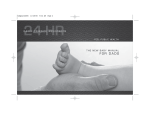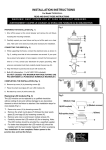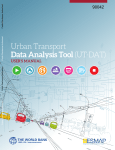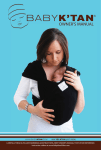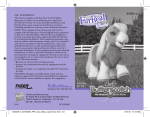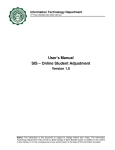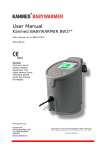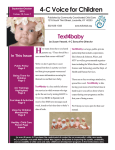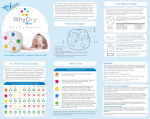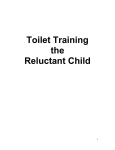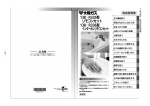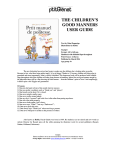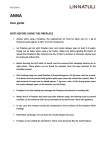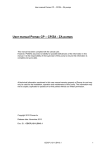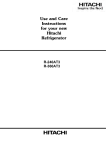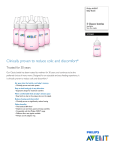Download Centacare new baby manual for Dads
Transcript
2 4 - H R C O T S I D E A S S I S TA N C E THE NEW BABY MANUAL THE NEW BABY MANUAL FOR DADS FOR DADS g Lookin n .0 Fuel Consumption 4.0 e nc a orm rf Pe 2.0 n Fu d an .0 Fin e Tu n ing Dad's 10 KM/H g otin 20 tio .0 12 era 18.0 e vic Op .0 od 14 the Ho er S elf fe Tool Kit Under s ur Yo -ItDo Sa .0 21 Sho ble u o Tr Now that you’re a proud father of a new baby, here are a few tips on getting the best performance out of your model. WARNING! WARNING! Your baby requires a “breaking-in” period. You need to spend lots of time during this “breaking-in period” to get to know your unique model. Free time might be limited. You might wonder what you’ve gotten yourself into but be patient. Remember, mum has been test driving this model for the past 9 months and has a head start. Before you know it, you’ll be head over heels in love. It is important to start a good routine of regular maintenance. The baby will become much more portable and flexible as days go on. Taking care of such a small baby may feel awkward at first but the sooner you get to it the faster you will become comfortable in the driver’s seat. It has been shown that top performing babies have very involved fathers. 1 2 3 4 5 6 7 8 9 10 11 12 13 14 15 16 17 18 19 20 21 22 23 24 A good supply of top grade breast milk and a happy mum are important to top performance of your model. Breastfeeding: • is best for baby • is free • is portable and requires no mixing or heating • makes for a smoother running baby (breast milk is easy to digest) • boosts the immune system which guards against illness (just like rust proofing) • makes for a quieter operation (less likely to be colicky) • lets baby eat as much as he/she needs • reduces the risk of cot death (SIDS - Sudden Infant Death Syndrome) • is cheaper to run Father’s support is very important for successful breastfeeding. 1 2 3 4 5 6 7 8 9 10 11 12 13 14 15 16 17 18 19 20 21 22 23 24 For a good supply of breast milk, fathers can do the following: • go to breastfeeding classes with mum for technical advice • feed mum • bring baby to mum • help with positioning of baby at breast • check baby’s attachment to mum’s breast (latch) during operation • support mum and tell her she’s doing a great job • burp baby • change baby when asked or whenever needed • hold baby after feedings to help settle to sleep • try to help mum relax and get extra sleep • check what mum may need (could be anything at any time of the day or night) To make enough breast milk, mum needs rest, sleep, and food. Your help is vital. Cooking (which also includes getting takeaway from mum’s favourite restaurant), cleaning (yes, the vacuum), answering the phone, entertaining guests (or telling them to come back another time), shopping, doing the laundry and dishes, along with all the things you did before, are a few small things which will help keep the breast milk flowing. Average Fuel Consumption 8 – 12 feedings per 24 hours (amounts and times are different for every model) Growth spurts usually occur at 2 weeks, 4 weeks, and 3 and 6 months cause an increase in fuel consumption. During these times, it is normal for a baby to feed frequently for 2 – 4 days. This too will pass. Adequate fuel consumption can be seen in the following ways: Waterworks (peeing) Day 1: Day 2: Day 3: Day 4: Day 5: Day 6 and after: 1 wet nappies 2 wet nappies 3 wet nappies 4 wet nappies 5 wet nappies at least 6 wet nappies Septic (pooing) Don’t be surprised if every time something goes in, something comes out the other end. However, for the first month, owners should be happy with 4 or more soft poos per day. 1 2 3 4 5 6 7 8 9 10 11 12 13 14 15 16 17 18 19 20 21 22 23 24 Electrical (sleep or activity) Baby usually settles after feeds. Baby is active and alert at other times. Weight During the first month, baby gains 150 g per week minimum. Baby regains any lost birth weight by 2 – 3 weeks, doubles birth weight by 5 to 6 months, and triples birth weight by a year (remember this is baby not dad). **Low Fuel Warning: Get help if your baby: • does not feed at least 8 times in 24 hours • has fewer number of wet nappies than number of days old (if your baby is less than 6 days old) • has less than 6 wet nappies per day (if your baby is 6 days or older) • is very sleepy and hard to wake up to feed • has yellow skin and eyes and is not feeding well • has less than one dirty nappy in 24 hours For technical assistance with breastfeeding contact: Australian Breastfeeding Association www.breastfeeding.asn.au Maternal and Child Health Centre (see your local council) 1 2 3 4 5 6 7 8 9 10 11 12 13 14 15 16 17 18 19 20 21 22 23 24 For your baby to have a safe and long life, the manufacturer recommends: • always use a car seat • read the instructions before putting together baby equipment (your baby’s life depends on it) • keep one hand on baby at all times during nappy changes (models may lurch and roll unexpectedly) • never shake a baby (shaking can cause permanent brain damage and even death) • put baby to sleep on his/her back to help prevent SIDS 1 2 3 4 5 6 7 8 9 10 11 12 13 14 15 16 17 18 19 20 21 22 23 24 Dad’s guide to effective burping (the baby that is) • Burping is helpful to avoid build-up of wind. • Dads can become pros at this in no time (some babies burp on their own). • Place baby on your shoulder and pat gently but firmly on the back. This can easily be done sitting in your favourite chair or while strolling around the house. WARNING! Some models will eject liquid when burping (this is normal). The manufacturer recommends using some kind of tarp (i.e. blanket) on your shoulder or standing near a sink. Five ways to calm a cranky baby • Cuddle (you remember cuddling) or wrap baby up in a blanket. • While holding baby, gently bounce or walk with the baby while speaking softly (“sh...sh...” works well or point out the interesting features in your workshop or on your computer). • Whisper in his or her ear. • Go for a walk or car ride. • Be silly - sing or make funny faces. 1 2 3 4 5 6 7 8 9 10 11 12 13 14 15 16 17 18 19 20 21 22 23 24 Does it really need to be changed? Some dads prefer the sniff method, some peek, and others can tell by the feel of the nappy. 1 2 3 4 5 6 7 8 9 10 11 12 13 14 15 16 17 18 19 20 21 22 23 24 Oil Changes • Girls - wipe from front to back. • Boys - when washing, treat the penis like a finger. DO NOT PULL BACK FORESKIN • Most babies will pee when they get cold, so keep that penis covered unless you want to get showered. • Point penis down, to avoid leaking from the top. • Tabs come from the back of the nappy and fasten to the front. • Cloth nappys need to be rinsed in the toilet and stored in the bucket. Don’t forget to dispose of the disposables. Is it supposed to be that colour? Black - baby’s first poos are black and sticky (known as meconium). Once the baby is getting good amounts of breast milk (or formula) it will change from black to greenish black to brown or yellow. Mustard coloured - seedy, loose poos are normal for breastfed babies. White - it is normal for girls to have a whitish jelly-like discharge from their vagina. This will eventually get cleaned off. Red - girls also can bleed a small amount from the vagina in the first few days. This is normal and is caused by mum’s hormones. Orangey red - babies that are 1 – 3 days old may have one or two orangey-red coloured spots in the nappy. The baby is not bleeding but has passed uric acid crystals. If this continues past 3 days, call your doctor or child maternal heath line. 1 2 3 4 5 6 7 8 9 10 11 12 13 14 15 16 17 18 19 20 21 22 23 24 Your tool kit should contain: • nappies - at least 3 or 4 • wipes • change pad • complete change of clothes for baby (pick an outfit you can put on easily) • nappy cream (if using) • plastic bag (for dirty nappies) Sometimes as a dad you may feel awkward, but as your baby grows you will develop a very special relationship. Even though it may seem like mum is in the driver’s seat, take responsibility for some aspect of regular maintenance like the bath or bedtime. 1 2 3 4 5 6 7 8 9 10 11 12 13 14 15 16 17 18 19 20 21 22 23 24 Exhaust(ion) is likely with a new baby. Your baby will not sleep through the night for several months. This can be hard on drivers. Babies are designed to wake up and refuel every few hours. Eventually, they will start sleeping longer. They also like to know that you are both around for them. In the meantime, try to take turns at sleeping-in, go to bed earlier (and not necessarily at the same time), and nap. If one partner is rested, the other partner can function better. When will we ever have sex again? It is important to remember that after having a baby, mum needs time to recover. Good communication and not pressuring or rushing mum helps. Mum may be hesitant at first. However, with time (and some sleep), this shall pass. For a well-tuned family, it is important to talk to mum and maintain your relationship as a couple. Talk about something (anything) other than the baby. Remember, mum drives this model all day. You may be worried about balancing work and home. This may be a time to look at your options and talk to your partner about them. Plan time together. Go on a date. 1 2 3 4 5 6 7 8 9 10 11 12 13 14 15 16 17 18 19 20 21 22 23 24 Problems Causes What to do? Crying baby • Hungry • Feed your baby. • Tired • Rock baby gently in your arms or in a cradle. • Wind • Burp baby during and after feeding. • Hold baby and rub his/her back while walking around your house singing your favourite tunes. Crying Mum • Boredom • Change baby’s surroundings. • Cold • Bundle baby in blanket or put on another layer of clothing. • Uncomfortable • Take off a layer of clothing if baby is too hot. • Make sure nothing is pinching or poking baby. • Smelly or damp • Change nappy (and clothes if necessary). • Emotional • Comfort, cuddle, sooth and reassure. • Normal baby blues • Be supportive and reassuring. Be patient. • Overtired and over- whelmed • Postnatal depression • Encourage mum to nap, take over as many household chores as possible (take initiative and don’t wait for mum to ask for help), limit visitors, tell her what a good job she’s doing. • Encourage mum to seek professional help if feelings of sadness, anger, guilt, anxiety, fatigue and inadequacy persist. Problems Causes What to do? Breastfeeding difficulties • Sore nipples • Full and/or sore breasts • Help with positioning and attachment. • Encourage mum to get help before she stops breastfeeding. Call Australian Breast Feeding Association to talk to a Child Maternal Health Nurse, or your doctor or midwife. Don’t give up too quickly because breast milk really is the best food for your baby • Encourage mum to feed more often. Sore or tender breasts are normal when milk comes in – this too will pass. • Mum and baby learning what to do • Support and encourage mum. • Normal infant bowel sounds (sometimes heard across the room) • Change nappy and do laundry. Noisy exhaust system 1 2 3 4 5 6 7 8 9 10 11 12 13 14 15 16 17 18 19 20 21 22 23 24 Problems Causes Spots, blotches, red rash • Normal newborn rash (anywhere on body) What to do? • Nothing. (It takes a while for baby’s skin to get used to air so they tend to get a lot of rashes, spots, etc.) • Nappy area • If it looks strange, compare notes with mum and call your Child Maternal Health Nurse for further information. • Thrush (white spots in baby’s mouth that look like milk curds) • Go to the doctor as baby needs medication for thrush - mum also needs to see the doctor if she is breastfeeding. Cone head • The birth process • Nothing. Baby’s head will become less pointy in a very short time. Anything • Don’t know • Call Maternal Child Health Nurse 65 Baxter St Bendigo Vic 03 54439577 Call or see your Family Doctor or Midwife FOR MORE INFORMATION AND HELP Adapted and reproduced with permission of Public Health, Region of Peel. Printed by BMP total image management www.bmp.com.au FOR MORE INFORMATION AND HELP




























